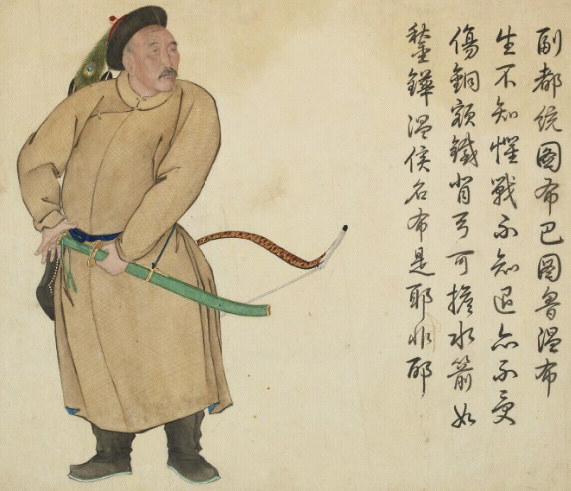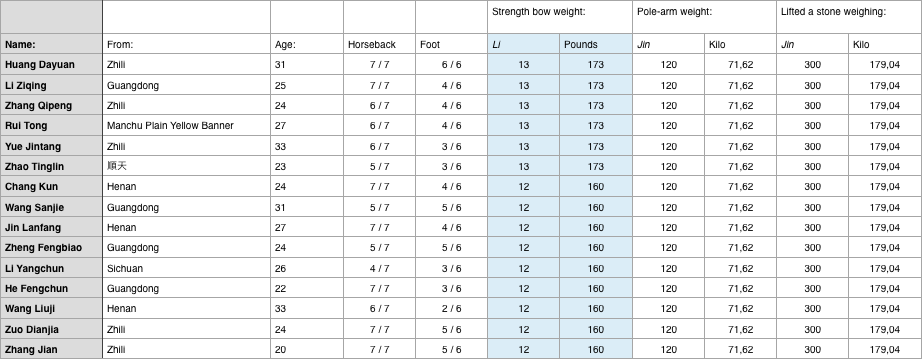By Peter Dekker, April 11, 2014
Originally published as part of A PRACTICAL GUIDE TO MANCHU MILITARY ARCHERY
Journal of Chinese Martial Studies, Winter 2012. Issue 6. Three-In-One Press, Hong Kong. 2012.

"Vice Commandant, Loyal Hero Wen Bu
In his life he knows no fear; in battles he does not retreat, nor does he get injured.
His head is made of bronze, his back of iron.
His bow is strong enough to carry buckets of water, his arrows as forceful as ploughs."
Historical military draw weights are often met with skepticism. It is often assumed that the records must have been either exaggerated or were describing only a small minority of men of unusual abilities. However, historical evidence for widespread use of high draw weights in the Qing military, up to the very last years of the dynasty, is compelling:
"In regularly held contests, expertness might be demonstrated by accuracy of aim, length of shot, or strength in drawing. It was the last of these that occasioned the most detailed comments by supervising officers. Bows were graded by "strength" from three [40 pounds] to as high as eighteen [240 pounds], according to their stiffness. Ability at strength of six (probably a pull of about 80 pounds) was considered minimal for a grown man, and strength of ten (about 133 pounds) was required for participation in hunts."
"A 1736 report found that of 3,200 troops at the Hangzhou garrison about 2,200 were able to draw bows of strengths six to ten [80-133], and 80 could handle bow strengths of eleven to thirteen [147-173 pounds]… …In comparison, the 500 troops at the small Dezhou garrison acquitted themselves with honor, all of them being able to take a five-strength bow [67 pounds], 203 a six-strength [80 pounds], 137 a seven strength [93 pounds], and 85 a ten-strength bow [133 pounds]."
"The champion in a 1728 contest between the one hundred top bowmen in the empire won one hundred taels when he hit the bull's-eye using an eighteen-strength bow an estimated drawing weight of almost 240 pounds!"
Source:
Mark C. Elliott, professor of Chinese and Inner Asian History at Harvard University.
From: The Manchu Way, Stanford University Press, 2001, pages 179 & 180.
(My own converstions in brackets.)
"The bows made for the army were made of four weights, 70, 80, 90, and 100 pounds pull."
Source:
Jesuit missionary Jean Joseph Marie Amiot.
From: Art Militaire Des Chinois, Didot L'Ainé, Paris, 1772. Page 387.
"Their bows ... require the power of from seventy to one hundred pounds in drawing them; the string is composed of silk threads closely wounded, and the arrows are well made and pointed with steel."
Source:
William Alexander and George Henry Mason, accompanied the Macartney Embassy to China in 1792.
From: Views of Eighteenth Century China: Costumes, History, Customs, reprint, London: Studio Editions, 1988, 132.
“In archery the Chinese have long been experts, especially those of Manchuria and Szechuan. (…) Their bows are graded according to their pull, the standard being 100 catties, about 135 pounds."
Source:
Hong Kong telegraph of August 17, 1893
“The Manchus had long emphasized mounted archery... ...when they first established their state their archery was as follows: they used bows of eight li draw weight [approx. 106 pounds]... ...whatever they hit, they pierced, and they could even transfix two men with some power to spare.”
Source:
Quoted from Xu Ke, Qingbao Leichao (Categorized Anthology of Petty Matters from the Qing Period), 1917.
Translation by Stephen Selby in Chinese Archery, Hong Kong University Press, Hong Kong, page 348.
"In the competitions five kinds of bow were used, those from eight to twelve "strength" [106 - 160 pounds]. Besides the bows of recognized official standard, bows of four, six or seven "strengths" [50, 80 and 93 pounds] were used for preparatory training or exercise."
Source:
Doug Elmy, Exercise and Test Bows, Society of Archer Antiquaries Journal 26, 1983.
“The Chinese bows are large and powerful... Bows of 150 pounds are by no means rare in China. The arrows used at the siege of the Legations in 1900 are 3 feet 5.5 inches long and 7/16 inch in diameter with heavy socketed steel heads. Some of the whistling arrows are 4 feet 2 inches long with heads four inches in diameter and six inches long. The bows that I saw in Peking that were used with such arrows were huge, about six feet long strung, with a cross section at the handle of nearly two square inches. They were said to pave a pull of about 200 pounds and looked it."
Source:
George Cameron Stone, Glossary of the Construction, Decoration, and Use of Arms and Armor in All Countries and in All Times, 1934.
Jack Brussel, New York, 1961. (Reprint) Page 134.
“I was strong from my childhood onward, with fine muscles; I could bend a bow with a pull of 15 li [about 200 pounds] and shoot a fifty-two inch arrow.”
Source:
The Kangxi Emperor (ruled 1661 - 1722)
From Jonathan Spence, Emperor of China: Self-portrait of K'ang-Hsi, Alfred A. Knopf, New York, 1974, page 148.
Antique bows
We also have tangible evidence to confirm that the emperors indeed walked their talks. In the collection of the Palace Museum in Beijing are numerous bows that belonged to emperors that still have their original inventory tags. Among them a 100 and a 147 pound bow that both belonged to the Kangxi emperor and a 93 pound bow that had belonged to the Qianlong emperor (ruled 1736-1796). Apart from that, many Manchu bows I examined in various private and museum collections with dimensions that put them well in the 100 pound range. Some old bows that were strung up by bow maker Wen Chieh Huang turned out to be between 70 and 160 pounds.
Source:
The Complete Collection of the Treasures of the Palace Museum. Volume 56: Armaments and Military Provisions.
Hong Kong, The Commercial Press, 2008.

My translation of the list:

Another list of results can be found in my article Jiangnan examination results.
From these two lists of results we can gather that it was common among candidates to at least be able to pull 160 pound bows. This makes sense, because of the three strength tests, only one weight could be lowered to still be a successful candidate. Most chose to lower the weight of the bow, indicating that that part was deemed the hardest part of the strength exams.
Were the archers of the Qing exceptionally strong?
The archers of the Qing were by no means unique in their use of high draw weights. Adam Karpowicz examined a number of Ottoman bows in the Topkapi Palace armory and came to an estimated 112 pound average for 26 bows with a standard deviation of 18 pounds. Old English warbows found on the Mary Rose warship that was sunk in 1545 were estimated to range in draw weight between 100-180 pounds. References to similar draw weights also appear from Persia, Mughal India, Japan, and other cultures from the times when their armies relied mainly on archers. Draw weights in excess of 100 pounds seem inhuman to recreational archers but there are countless archers in our time who have learned how to shoot in the 100 pounds range, with the current Guinness world record/a> being held by Mark Stretton at 200 pounds.
That said, Manchu bows are unique in that they have the highest initial tension of all bows, and thus are harder to pull at a given high draw weight than other types of bows. They typically are at 75% of their max draw weight at 20" pull already, where a longbow would pull around 45% of it's max draw weight there. As a result, the weight is higher before one can do the so-called "shoulder roll" that enables archers to pull exceptionally heavy bows. This high initial tension is where the Manchu bow's extra energy comes from, making it capable to shoot large and heavy arrows so well. It is also what makes the Manchu bow a harder bow to progress with in weight, and at the higher weights is very prone to shoulder injuries especially in the first stages of the draw.
1Adam Karpowicz, Ottoman Turkish Bows, self-published, 2008. Page 46.
2Hardy Strickland and Robert Matthew, The Great Warbow: From Hastings to the Mary Rose, Sutton Publishing, 2005.
Caveat!
Caution is advised. In 1727 the Yongzheng emperor noticed a trend among his men to proceed too quickly and get injured in the process:
“If there are those who wish to learn how to use a hard bow, they should practice naturally, gradually increasing the strength of the bow. How can one go to such extremes as to take medicine? Unless one knows the nature of the drug there is the chance that people will be hurt. Besides, using a hard bow on horseback is difficult, so what is the advantage? A bow that is of strength six [80 pounds] or greater is enough.”
Those who were eager to master the use of hard bows were in the emperor's view all "ambitious" (心上进之人), and for that reason the greater the pity that they were wrongly harming themselves.
Edict from the Yongzheng Emperor, ruled 1722 - 1735.
Mark C. Elliott, The Manchu Way, The eight banners and Ethnic Identity in Late Imperial China. Stanford University Press, 2001. Page 180.
I learned this the hard way, with a shoulder injury that took me out of archery for a few months. Listen to your body and progress slowly over a longer period of time, if this is a path you want to pursue. Also, always warm up with lighter bows before pulling higher weights.
Conclusion
If 80 pounds is good enough according to the Yongzheng emperor, and reports suggest that 75 men in Dezhou used 67 pound bows in 1736, we have established our lower threshold: Soldiers shot bows from about 67 pounds and up, and 80 or more was considered sufficient by their ruler. It makes sense, from my experience in shooting accurate replicas of Qing military arrows of identical size and weight as the antique ones, I noted that 65 pounds is around the very minimum required to propel them with sufficient force but their effective range then is still rather unimpressive. At 80 pounds, the performance is getting rather impressive. See the test results in my article the Manchu bow on this website.


